
Brown Snake
Latin name: Storeria dekayi
Size: 5 to 15 inches
Venomous: No
The brown snake rarely gets any longer than around 14 or 15 inches, but they do have quite stout bodies, and they can often be confused with other snake species. This is especially the case for juveniles, which have a pale-colored ring around the neck, making them appear similar to ring-necked snakes.
This snake eats whatever it comes across underground — where it spends almost all of its time. This includes slugs and snails, earthworms, beetles, and various other grubs and insects. Above ground, it can eat lizards, but it is then vulnerable to predatory attacks from larger snakes, birds of prey, domestic pets, and even large toads.
Bull Snake
Latin name: Pituophis catenifer
Size: 36 to 84 inches
Venomous: No
Also known as the Pacific, coast and western gopher snake, or just the gopher snake, the bull snake is commonly confused with the prairie rattlesnake in Wisconsin, but the latter usually has a much wider head than the former, plus the bull snake is also missing stripes of darker color on the tail.
This snake is classed as a species of special concern in the state, and it inhabits sandy, dry spaces, such as savannas, prairies, and hardwood (pine/oak) barrens.
 Eastern Fox Snake
Eastern Fox Snake
Latin name: Pantherophis gloydi
Size: 4 to 8 inches
Venomous: No
The eastern fox snake usually inhabits areas to the east of the Mississippi River, in spaces that are wet, but partially drained — marshes, swamps, fields and meadows adjacent to bodies of water, and other types of wetland, although sightings are quite rare in the state.
Although not dangerous, this species of snake mimics the actions of the venomous massasauga rattlesnake, shaking its tail from side to side to ward off predators. Some colourations also make the eastern fox snake look very similar to the copperhead, which is also venomous. Because of this, they are often killed in a defensive act by humans, and in many states, populations are so low that the snake is on the endangered or threatened list.
Western Fox Snake
Latin name: Pantherophis vulpinus
Size: 35 to 70 inches
Venomous: No
Despite being a non-venomous species of snake, the western fox snake often gets killed by humans after confusing it with one of two other venomous snakes: the rattlesnake, or the copperhead. In actual fact, the non-aggressive western fox snake provides somewhat of a helping hand to humans, keeping populations of rodents and other pests down, such as rats, mice, rabbits, birds, and voles.
The yellow underbelly of this snake species is usually a yellow color, decorated with a checkerboard-like pattern. The main dorsal body of the snake often has dark black or brown spots across a lighter backdrop — lighter shades of brown and olive.
Butler's Garter Snake
Latin name: Thamnophis butleri
Size: 14 to 20 inches
Venomous: Yes
The Butler's garter snake is one of five garter snake species, and the smallest of them all. It is also a species of special concern in the state, with populations decreasing more and more in recent years due to a number of human-related factors. This snake interbreeds with the plain’s garter snake in Wisconsin, causing a hybrid which could also partially lead to the decline in original subspecies numbers.
Found in the eastern/north-western part of the state, this snake prefers moist or wet habitats, including the edges of ponds, streams and lakes; and you may also find it in moist grasslands and scrub forests.
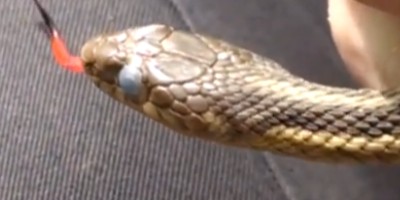 Common Garter Snake
Common Garter Snake
Latin name: Thamnophis sirtalis
Size: 17 to 26 inches
Venomous: No
The common garter snake, also known as the eastern garter snake, is the most common type of snake found in Wisconsin, with populations in almost every part of the state. It's an adaptable species, capable of living in many different habitat types. In this state, however, it tends to favor the edges of woods and forests, and shrubby or grassy fields. It also seems to be encroaching on residential areas more and more, especially properties with outbuildings, sheds, or barns.
Plains Garter Snake
Latin name: Thamnophis radix
Size: 20 to 28 inches
Venomous: No (Yes, but it doesn't affect humans)
There were once two subspecies of plains garter snake: the eastern and western subspecies; but they have hybridised to such an extent that the two have become so similar that they can barely be told apart. This snake has a bright stripe that runs down the back of the body, often in an orange or yellow shade, sitting on top of a backdrop that is dark — often olive-green or gray/almost black.
A very adaptable species, the plains garter snake does well in a wide assortment of habitats, including residential areas, close to bodies of natural water, and other grassy and moist spaces. Despite its adaptability, the species is classed as a species of special concern because of declining numbers.
Smooth Green Snake
Latin name: Opheodrys vernalis
Size: 14 to 20 inches
Venomous: No
This green, sleek and slender snake is often confused with the grass snake, because of its bright green, grass-like appearance. In certain areas of Wisconsin, such as the central regions, and the northern ones, the bright green can be replaced by a tan-olive crossbreed of color, which is the color of most juveniles no matter what markings or colourations they grow into.
The color of this snake gives away the habitat: it likes green areas, preferably forest edges, prairies, grasslands, grassy backyards, oak savannas, and similar, where they make great use of the abundance of worms, bugs, grubs, and insects.
Eastern Hognose Snake
Latin name: Heterodon platirhinos
Size: 20 to 25 inches
Venomous: No
Also commonly referred to as the puff adder, the eastern hognose snake is a common species found in Wisconsin, and across many other states. The snake gets its name from the upturned nose it has, looking very hog-nose-like.
Coloring can vary, but usually consists of a golden-brown top body, covered in darker brown, almost black uneven spots. This colouration changes as hognose snakes get older and very mature species can look almost entirely black or very dark brown, completely devoid of spots or blotches. The underside of the snake also varies greatly, too; it can be pinky-cream, almost yellow, gray, and a combination of patterned/not patterned.
Lined Snake
Latin name: Tropidoclonion lineatum
Size: 8 to 15 inches
Venomous: No
The lined snake is also known by a host of other names, including swamp snake, dwarf garter snake, streaked snake, and common snake — which gives you some idea of where this species prefers to inhabit. Areas close to water with moist and soft, easy-moved soil is ideal, along with long grasslands.
A usually brown or brown-green-colored snake with a line running down the body (just as the name would suggest), it is relatively small, easy to miss, and has very small eyes in a narrow head. There is a pretty good chance that you would miss this snake if it was in the vicinity of it, especially as it prefers to stay hidden in soft soils, under loose leaves, within fallen branches and logs, and under boulders and rocks.
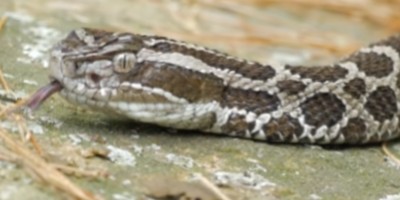 Eastern Massasauga
Eastern Massasauga
Latin name: Sistrurus catenatus
Size: 24 to 30 inches
Venomous: Yes
In the state of Wisconsin, south and southwestern areas specifically, you may encounter the eastern massasauga – a venomous species. Thankfully, bites from this snake are rare, although they do have the potential to be dangerous. The venom from this particular rattlesnake is currently being researched as it is thought to have properties that can treat various heart conditions.
Although venomous, this snake would much rather flee than fight a human-sized predator, although accidents can happen when walking in rattlesnake territories without looking where your feet are going.
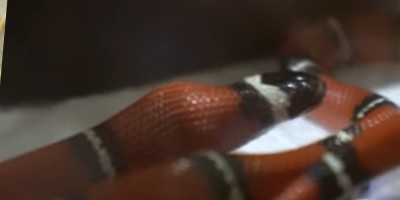 Milk Snake
Milk Snake
Latin name: Lampropeltis triangulum
Size: 24 to 36 inches
Venomous: No
The milk snake is found across almost all of Wisconsin, with the exception of the northernmost counties. Common on farmlands, in old barns, and in rural homes that have plenty of nooks and crannies, this species tends to live in pastures, old meadows, hardwood forests and oak savannas, in the wild, but is adaptable.
Also known as the eastern milk snake, scarlet king snake, and red milk snake, they are nonvenomous, but they put on quite the dramatic display when threatened, releasing musk, shaking the tail like a rattlesnake, and hissing loudly. It will bite if continually provoked.
Queen Snake
Latin name: Regina septemvittata
Size: 13 to 30 inches
Venomous: No
This snake is a semi-aquatic one, and one that requires rather specific habitat conditions in order to thrive. First of all, it needs clean and running water, so streams and rivers are perfect. Second of all, it needs to have a rocky bottom. And thirdly, it needs to have a population of preferably young crayfish — the queen snake's primary source of food.
Unlike other crayfish species, the queen snake doesn't have such bug-like eyes, but it does often look like others, and even other species entirely, including the ribbon snake. This snake is endangered in the state of Wisconsin.
Blue Racer
Latin name: Coluber constrictor foxii
Size: 30 to 70 inches
Venomous: No
Also known as the eastern racer, the blue racer is a species of special concern in Wisconsin, although it usually inhabits a mix of semi-open and open spaces such as edges of forests and woodlands, old farms and fields, and savannas. They don't regularly stray into areas with lots of humans, and they are quick to flee from disturbances.
This snake feeds on mostly rats and mice, but it will also eat other snakes, birds, and large insects. Juveniles have a diet that is primarily made up of insects. Generally, the species will be most active in the state from April through to late September or October.
Black Rat Snake
Latin name: Pantherophis obsoletus
Size: Up to 70 inches
Venomous: No
If you live or spend time in southern parts of Wisconsin, especially in areas with plenty of trees, you may come across the black rat snake, also known as the black snake, chicken snake, and common rat snake. A non-aggressive snake that has become popular in the pet industry, a wide and diverse range of colourings and markings have been bred into the species, some of which have been released into the wild. It is thought that this activity could see the black rat snake ‘s colour variations become much more diverse.
Gray Rat Snake
Latin name: Pantherophis spiloides
Size: 38 to 72 inches
Venomous: No
The gray rat snake is also dubbed the chicken snake, midland rat snake, or central rat snake, and is a species of special concern in Wisconsin, although can sometimes be seen in the south-west of the state, in oak forests and savannas. It is an excellent climber so you are just as likely to see this snake up in the branches as you are down on the ground — and it is becoming more and more comfortable living in close proximity to people, especially in old barns and farm buildings. It follows its main prey item: rats and other rodents, which are commonly found in human-inhabited spaces.
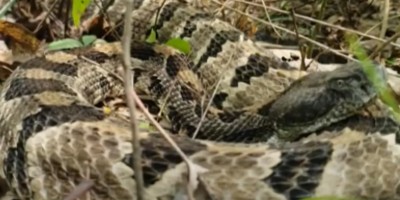 Timber Rattlesnake
Timber Rattlesnake
Latin name: Crotalus horridus
Size: 36 to 60 inches
Venomous: Yes
The timber rattlesnake is a species of special concern in the state of Wisconsin, with populations declining more and more over recent years, mostly due to human disturbances and degradation of natural habitats. Females tend to give birth every few years (3-5) in this state, which obviously doesn't help matters.
This rattlesnake has ridged scales that are usually yellow, brown, gray, or a combination of all three, with cross-bands over either black or a very dark brown shade. Occasionally, there will be what appears to be a red stripe, and the underside is yellow or cream, sometimes marked with dark patches.
Northern Red-Bellied Snake
Latin name: Storeria occipitomaculata occipitomaculata
Size: 8 to 16 inches
Venomous: No
In the state of Wisconsin, you may encounter the northern red-bellied snake in sphagnum bogs, boreal forests, hardwood forests, and also meadows or fields that sit close by to these areas. Sunnier days bring these snakes out in quite large numbers and many people report having seen them along walking trails, roads, and areas with low-lying vegetation close by.
With a bright red underbelly (although many variations are said to exist), the red-bellied snake has also earned itself the nickname fire snake, but it is a relatively harmless species. When handled, it might attempt to bite, but being such a small snake means that the teeth are also very small and bites are barely noticeable. (We still don't recommend provoking one, though!)
Northern Ribbon Snake
Latin name: Thamnophis sauritus septentrionalis
Size: 18 to 26 inches
Venomous: No
These snakes are great swimmers, and a lot of their food is what you would expect to find in or around bodies of water. This is why you might spot the northern ribbon snake in or around bodies of water, preferably open, including streams, lakes, rivers, ponds, swamps, marshes, and similar.
The ribbon snake is actually classed as an endangered species in the state of Wisconsin, because of the reduction of natural habitats, human attacks, and collisions with vehicles. If you believe you have spotted a northern ribbon snake, or other species of ribbon snake, in Wisconsin, effort should be made to leave it alone. The Endangered Species Law specifically states that it is illegal to take, transport, possess, process, or sell endangered species.
Western Ribbon Snake
Latin name: Thamnophis proximus
Size: 17 to 50 inches
Venomous: No
The western ribbon snake is a state-endangered, slender, fast-moving, and quite shy snake that usually inhabits brush areas close to bodies of water, such as ponds, streams, and lakes. With a dark-colored body (olive-green, brown, or very dark gray into black) and lighter underbelly, this snake looks much like many other non-venomous snakes in the area, but the stripes down the back give the game away. There are three of them: one on each side, plus another running down the centre. It is almost always a yellow-green color.
Northern Ringneck Snake
Latin name: Diadophis punctatus edwarsi
Size: 10 to 15 inches
Venomous: No
Often confused with the prairie ringneck snake, you can tell the northern subspecies apart by taking a look at the underbelly. In both snakes, the underbelly is a creamy-yellow color, quite in contrast with the blue-black scales that adorn the top of the body; but the northern ringneck has no belly markings, whereas the prairie ringneck tends to have splotches of darker shades. Interbreeding between the two species in Wisconsin has meant that ringneck snakes can sometimes show characteristics from both breeds, making it hard to tell the exact one.
The northern ringneck is also unique in that it likes to live in a forest of deciduous trees, quite unusual for most snake species.
Prairie Ringneck Snake
Latin name: Diadophis punctatus arnyi
Size: 12 to 14 inches
Venomous: No
The prairie ringneck snake is a snake of special concern in the state of Wisconsin, which means that numbers are declining and human conservation intervention is required to ensure the population doesn't drop away entirely in the state.
As the name suggests, ringneck snakes have a ring around the neck. This can be a variety of colours, but the prairie ringneck species usually boasts a bright yellow or bright orange, almost red band of color. The underside of the tail is often the same bright shade, and the underbelly is a pale creamy-yellow color. The main topside of the body is a dark color, usually very dark black and almost cloudy blue in nature.
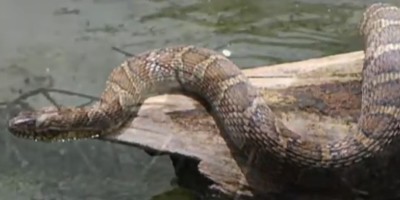 Northern Water Snake
Northern Water Snake
Latin name: Nerodia sipedon
Size: 20 to 55 inches
Venomous: No
It is actually quite common to see the northern water snake in Wisconsin during hot, summer days. They are active both during the day and night, although they have a preference for the day when temperatures are up, and the usually solitary snakes come together in basking groups to make use of the sun.
It is unlikely that you will be attacked for no reason by a northern water snake, but they are known to be aggressive when attacked or threatened. Unfortunately, humans often panic around this snake, because of its similarities to the cottonmouth/water moccasin, which is a venomous species.
Western Worm Snake
Latin name: Carphophis vermis
Size: 7 to 11 inches
Venomous: No
The western worm snake has a spiked but harmless tail that it will poke towards animals or humans that get too close, but the spike isn’t really designed to do damage; it is mostly to make the snake look more intimidating than it is. Looking like an earthworm doesn’t really do this species any favors, and that’s just one reason why it spends all of its time underground, where it eats earthworms rather than fall prey to predators such as birds of prey, larger snakes, and mammals.
This particular snake species is only really found in the southwestern part of the state of Wisconsin, but spending much of its time underground makes it tough to keep reliable records.